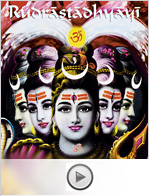 The Rudrashtadhyayi, or the 8 Chapters in Praise of Rudra, emanates from the Shukla Yajur Veda, one of the oldest expressions of spiritual wisdom known to mankind.Rudrashtadhyayi is the most acclaimed and celebrated hymn to Lord Shiva, and is chanted continually at all the jyotir lingams.
The Rudrashtadhyayi, or the 8 Chapters in Praise of Rudra, emanates from the Shukla Yajur Veda, one of the oldest expressions of spiritual wisdom known to mankind.Rudrashtadhyayi is the most acclaimed and celebrated hymn to Lord Shiva, and is chanted continually at all the jyotir lingams.
Rudrashtadhyayi celebrates Shiva, The Consciousness of Infinite Goodness, in his form as Rudra, the Reliever of Sufferings.The Vedic poems of the Rudrashtadhyayi convey the spiritual emotion, or bhava, of the passionate love and worship of Shiva.
Chanting them helps remove our suffering and grants us spiritual peace. The hymns are filled with inspiration, and the tones of their chanting conduct our vibrations to radiant purity.
The explanation of Rudrashtadhyayi in this video series grants the wisdom to move develop an intuitive understanding of the Sanskrit mantras and gives a clear explanation of the yoga system and yogic knowledge needed to incorporate this scripture into a personal spiritual discipline.
Rudrashtadhyayi Video Class 1: Introduction
Beginning Worship
In this video class the origins and meaning of the Rudrashtadhyayi are discussed and the preliminary worship rituals prior to recitation of the Sanskrit text is demonstrated. The mantras of Rudrashtadhyayi remind us we are one with All and everything is within us.
Rudrashtadhyayi Video Class 2: Chapter 1 and Chapter 2
Shiva Dhyanam, Nyasa, Sankalpa Stotram and Purusha Suktam
This class explains the Dhyanam, meditation on Lord Shiva and the nyasa for establishing his mantra in the body of the worshiper. The video then continues on to the first and second chapters of the Rudrashtadhyayi. Chapter 1 is a prayer to receive the sankalpa, or determination and focus of mind of Shiva. The 2nd chapter praises Shiva in His omnipresence.
Rudrashtadhyayi Video Class 3:
Chapter 3
The Spiritual Warrior
The 3rd Chapter is a blessing for the spiritual warrior within us, to prevail in the battle and defeat our own internal enemies. In this video class beautiful mantras of this hymn are chanted in Sanskrit and than a translation and discussion of the verses follows.
Rudrashtadhyayi Video Class 4:
Chapter 4
The Light of Wisdom
This video class discusses chapter 4 of the Rudrashtadhyayi. The 4th chapter sings the praise of Shiva as the Light of Wisdom, it contains beautiful verses describe the divine qualities of the Shiva, which are like the Sun. In the video class the Sanskrit verse are recited and then translated in to English and discussed.
Rudrashtadhyayi Video Class 5:
Chapter 5
Namakam
This class explains Chapter 5 of the Rudrashtadhyayi, also known as the Namakam. The 5th chapter has become especially famous as the Namakam because the verses contain various special names of Shiva to which we bow in devotion and offer our oblations. Namakam comes from the words “Namana” and “kara”, which means we bow. The Sanskrit mantras of the Namakam, the 5th chapter of the Rudrashtadhyayi, are first chanted and then translated and explained in great depth in English. In the 5th chapter we bow to Shiva in all of his forms.
Rudrashtadhyayi Video Class 6:
Chapter 6
Asking for Shiva’s Blessings
In the 6th chapter we pray to Shiva and ask him for his blessings. This chapter contains the Mahamrityunjaya Mantra, which like the Rudrashtadhyayi, is found in the Yajur Veda. The video class contains both the Sanskrit mantras of the Rudrashtadhyayi and their translation and explanation.
Rudrashtadhyayi Video Class 7:
Chapter 7
Offerings to Shiva
In the 7th chapter we make offerings to Shiva’s various manifestations. There is nowhere where he is not present. In this way we offer to him on all levels, from the physical to the subtle to the casual until ultimately we are one with Shiva. The video class contains both the Sanskrit mantras of the Rudrashtadhyayi and their translation and explanation.
Rudrashtadhyayi Video Class 8:
Chapter 8
Chamakam
This video explains Chapter 8 of the Rudrashtadhyayi, also known as the Chamakam. In the Chamakam we recite many of Shiva’s divine characteristics that are within us, and after each one “cha” is inserted, meaning “and”. Therefore it is called the Chamakam. In this video class the Sanskrit mantras of the Chamakam are recited and then translated and deeply explained.
Rudrashtadhyayi Video Class 9:
Chapter 9
Peace Chapter, Shiva Arati, Pranam
In the 9th Chapter we pray to Lord Shiva and ask for peace and offer peace to all existence. This video class also contains the Shiva arati, the dance in celebration of Shiva and the Pranam which is bowing down in thanks for having been able to perform the sadhana of this beautiful scripture. Both the recitation of the Sanskrit mantras and their translation and explanation in English are contained in this class.